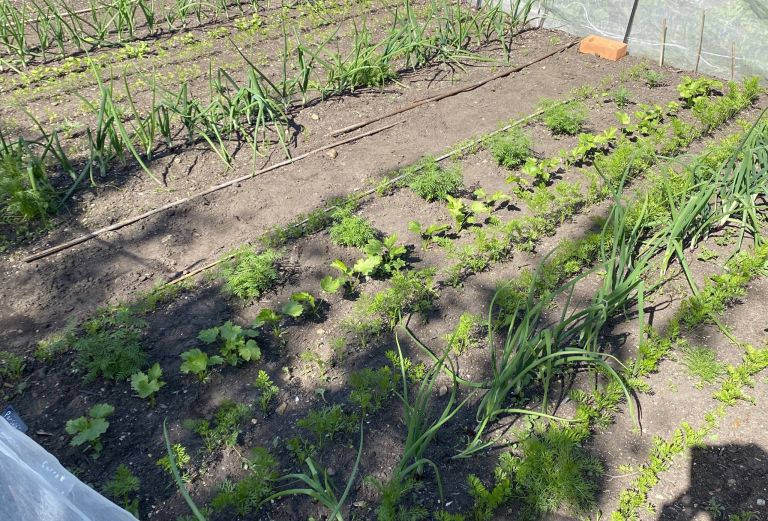
Written by garden apprentice Sophie.
Has anyone ever asked you this trick question? What’s 1+1? 2+2? 4+4? 8+8? Name a vegetable?
Most people say carrots, it’s a good trick to catch people out. Can you read their mind? Or are carrots just growing in our thoughts. They help us see in the dark right? Bugs bunny put himself in constant danger for the humble carrot. So did peter rabbit come to think of it. Carrots are used in lots of different cuisines and are familiar to people in many parts of the world. Here in Britain, we eat them all year round, in soups, raw in salads and roasted at Christmas.
We are all of course familiar with the orange carrot. It came to Britain in the 16th century from Holland where the original red, purple, black, yellow and white varietals were hybridised to today’s bright orange, with its potent dose of beta carotene. India, China and Japan had established carrots as a food crop by the 13th century. So, we were fashionably late to the party. In Europe they were prescribed for medicinal purposes, the Romans even called them ‘Philtron’ and used them as a love medicine. It’s even said the Elizabethans used the feathery stalks as decoration in their hair. Today many people use the stalks to make pesto.
Carrots originated in modern-day Iran and Afghanistan, they are drought resistant and take up little space. They can be sown regularly from early spring. The first carrots in the walled garden at Fulham Palace were sown in mid-March and are now ready to be eaten. We have five varieties – including purple carrots – they are sown in succession every two weeks so we can regularly harvest and avoid a glut of produce.

Carrots are in the Apiaceae family, the same as cow parsley, fennel, hemlock and celery. You might recognise the umbel shape of the flowers in all of them. Carrots are a relatively easy crop to grow but they do have some problems. The most well-known is the dreaded carrot root fly, whose larvae feed on the roots of carrots. The larvae tunnel into the developing carrots causing them to rot. But, we can stop the fly by making a carrot compound or carrot net which is a fine mesh net that stops the low-flying female flies. The net needs to be about 60 cm tall, the one in the walled garden is a bit taller at around 80 cm or four Edmunds tall. It creates a border or wall around the edge of the bed but is open at the top.
Carrots are also susceptible to aphids, they feed on the soft shoots and excrete sap which can also cause mould to grow. To help prevent the attack of aphids we have companion planting, we have planted marigolds as well as onions. The onions’ scent works as a deterrent to the carrot fly.

The other problem I have come across specific to Fulham, thankfully not rabbits, is the appearance of some unwanted potatoes. We work on a crop rotation in the veg garden, which is another measure we take to prevent pests. By rotating, we stop the build-up of a crop’s specific pest in one area. The bed the carrots are in now was last year’s potato bed, I have discovered not all of the potatoes were happy to leave which is not ideal for the little carrot seedlings to be disturbed by huge potatoes. Nevertheless, I have dug out and cut back and pruned where I can, and seem to have won the battle.
If I say so myself, the carrots have turned out very well so far. Pop down to the walled garden to marvel at the carrot fortress and head straight to the barrow if you fancy taking some carrots home.
The walled garden barrow sells organically produced vegetables, plants and fresh-cut flower bouquets all grown right here at the Palace!